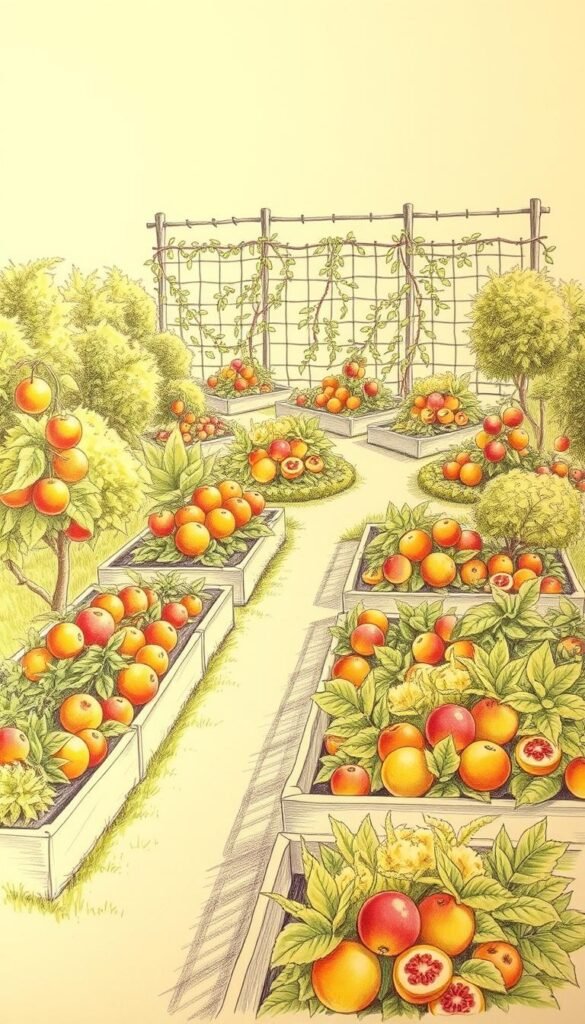Think your yard’s too small for fresh berries or homegrown apples? Think again. Even compact spaces like 2’ x 2’ corners can host pruned gooseberries, while a 4-foot stretch might surprise you with blueberry bushes yielding 4-6 quarts of juicy fruit. Whether you’re working with narrow strips or circular plots, smart design turns limitations into opportunities.
This guide walks you through transforming any space into a thriving edible oasis. You’ll learn how to assess sunlight patterns, choose space-smart plants, and use vertical growing methods that double your harvest potential. From espalier-trained apple trees to container-grown strawberries, we’ve got solutions for patios, balconies, and awkward backyard corners.
Discover how proper soil prep and strategic placement help dwarf fruit trees produce 20-25 apples in tight quarters. We’ll show you common pitfalls to avoid—like overcrowding plants or neglecting pollination needs—and share pro tips for maximizing yields season after season.
Ready to enjoy homegrown sweetness without acres of land? Let’s turn your gardening dreams into bite-sized, harvest-ready reality.
Understanding Your Garden Space and Its Potential
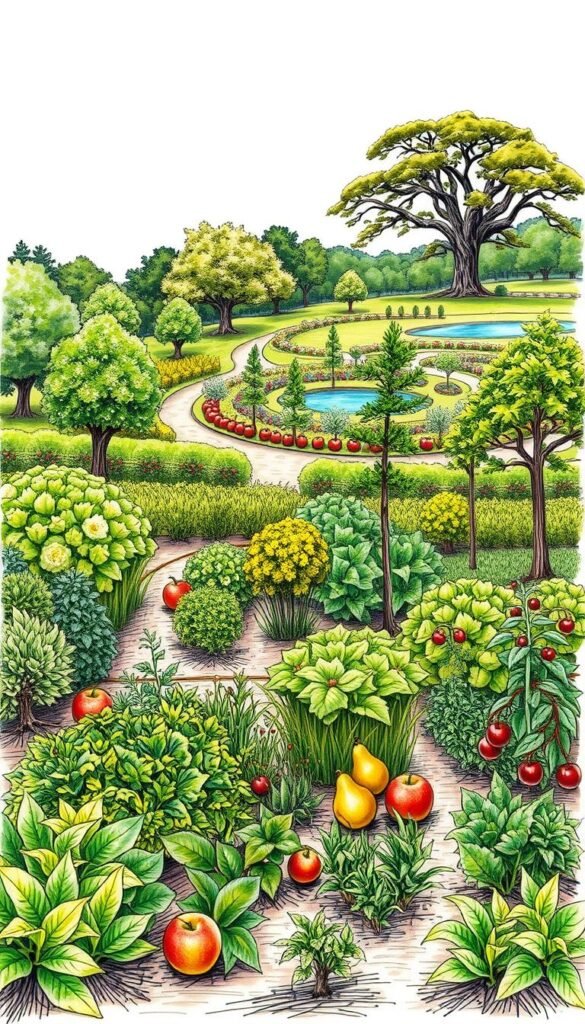
Your outdoor area holds hidden growing power – even that awkward strip by the garage or sunny patio corner can become a fruiting hotspot. Let’s uncover how to match plants to your unique setup while avoiding common sizing mistakes.
Measure Twice, Plant Once
Grab a tape measure and notebook. Sketch your available areas – narrow 2-3’ strips work for espalier pear trees (yielding 60+ fruits in 8 linear feet). A 4’ wide bed fits three blueberry bushes, while circular spaces 8’ across can host mini-orchards. Remember: dwarf apple trees need just 6’ of vertical clearance with annual pruning.
Sunlight & Soil Secrets
Track light patterns for 3 days. South-facing areas bake strawberries but suit figs perfectly. Check drainage by digging a 1’ hole – if water remains after 8 hours, build raised beds. Pro tip: plant gooseberries in 2’x2’ corners where other crops struggle.
Smart gardeners double their harvests by pairing compatible plants. Try underplanting apple trees with shade-tolerant herbs, or edge blueberry beds with compact marigolds. Your garden’s microclimates matter too – warm brick walls extend grape growing seasons, while low spots risk frost damage to early-blooming plums.
Analyzing Sunlight and Water Requirements
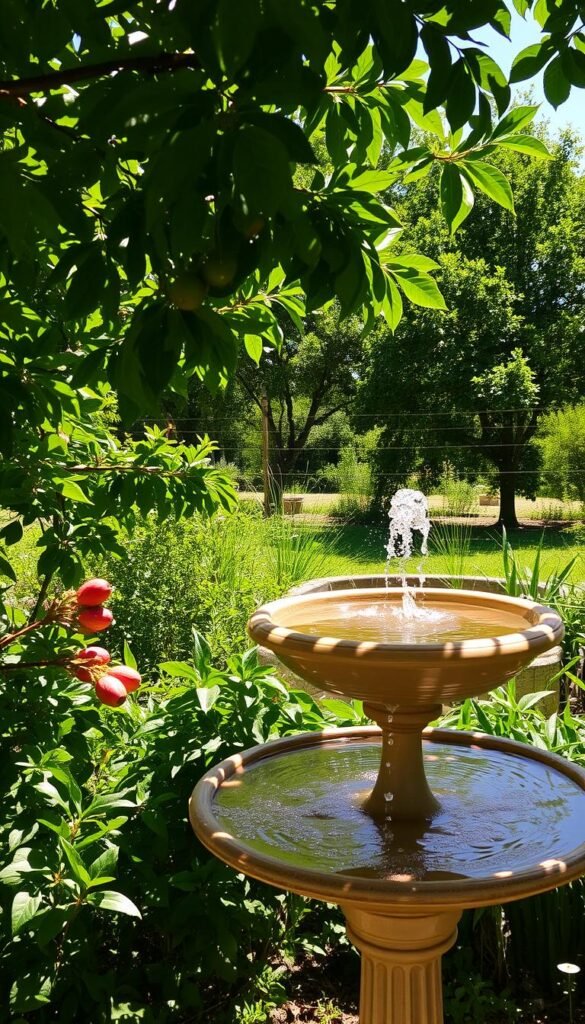
Sun and water aren’t just essentials—they’re the secret sauce for juicy harvests. Let’s decode how to map these elements in your space without guesswork.
Sunlight: Nature’s Growth Switch
Track light like a pro using this trick: where the full moon shines in January, expect summer sun. Most fruiting plants need 6-8 hours of direct rays. Blueberries thrive with 6 hours, while grapes demand 8-10. Got a shady corner? Gooseberries produce in half-day sun.
Water: Your Liquid Lifeline
Position your plot within 25 feet of a spigot. This prevents watering burnout—studies show gardens closer to water sources get 40% more consistent care. Use soaker hoses in raised beds to cut maintenance time.
Smart placement avoids these pitfalls:
- Morning sun areas dry out slower (perfect for raspberries)
- South-facing walls create heat traps for figs
- Low spots collect cold air—bad for early-blooming plums
Remember: Dwarf apple trees in containers need daily water checks. Pair thirsty plants like blackberries near rain barrels. Your future self will thank you when harvests overflow!
Incorporating Companion Planting and Edible Landscaping
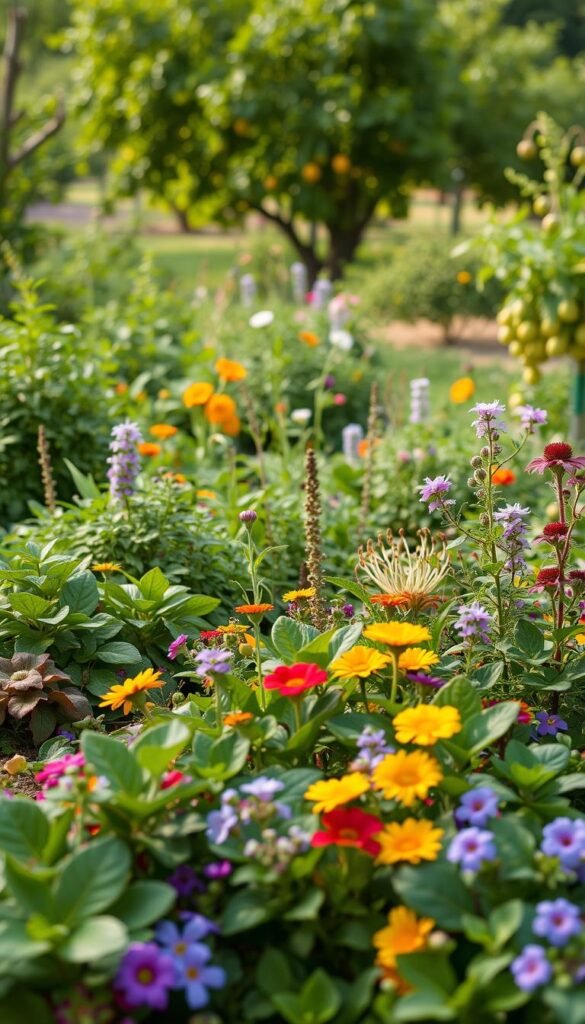
Did you know basil makes tomatoes taste sweeter? Strategic pairings transform your plot into a living ecosystem where plants actively support each other’s growth. This approach boosts yields while creating eye-catching edible displays.
Selecting Compatible Plant Friends
Tomatoes thrive with onion neighbors that repel aphids, but wilt near broccoli. Try this winning trio:
- Tomatoes + basil (improves flavor)
- Carrots + oregano (deters carrot flies)
- Peppers + marigolds (blocks root-knot nematodes)
Peppers love sharing space with eggplant and squash – their broad leaves create living mulch. Avoid planting them near beans, which compete for nitrogen. For container-specific pairings, explore our best companion plant combinations.
Edible landscaping shines when you layer plants vertically. Train raspberries up trellises behind dwarf apple trees, with thyme carpeting the ground. This “food forest” approach yields 3x more harvests than single-layer beds while looking magazine-worthy.
“My pepper harvest doubled when I swapped cabbage for basil neighbors.” – Oregon home gardener
Smart pairings extend your harvest window too. Quick-growing radishes mature between slowpoke peppers, giving you two crops from one space. Remember: incompatible vegetables placed too close can reduce yields by 40% through root competition.
Planning a Fruit Garden Layout: From Sketch to Planting in 5 Easy Steps
Transform your outdoor space into a productive paradise with smart design strategies. Grab graph paper and a pencil—each square represents 1 square foot of real estate. This visual approach helps prevent overcrowding while maximizing yields. Mark existing trees, fences, and sunny zones first.
Keep beds narrow—3-4 feet wide lets you reach every plant without compacting soil. Allow 2-foot pathways between planting areas for easy wheelbarrow access. Pro tip: Outline curved beds with garden hoses before committing to permanent shapes.
Three proven systems work magic in small spaces:
- Block planting: Divide your plot into quadrants for crop rotation
- Row systems: Align taller specimens north-to-south for even sun distribution
- Square foot gardening: Grow 16 carrot plants or 1 pepper bush per grid square
Time your plantings like a pro. Schedule strawberries 4 weeks before last frost, then follow with heat-loving figs. Did you know? Interplanting fast-growing radishes between slow-developing blueberries gives you two harvests from one space.
Finalize your plan with color-coded markers for each fruiting species. This living blueprint evolves with each season—track what thrives where to refine future layouts. Your personalized edible masterpiece awaits!
Selecting the Optimal Plant Varieties for Your Garden
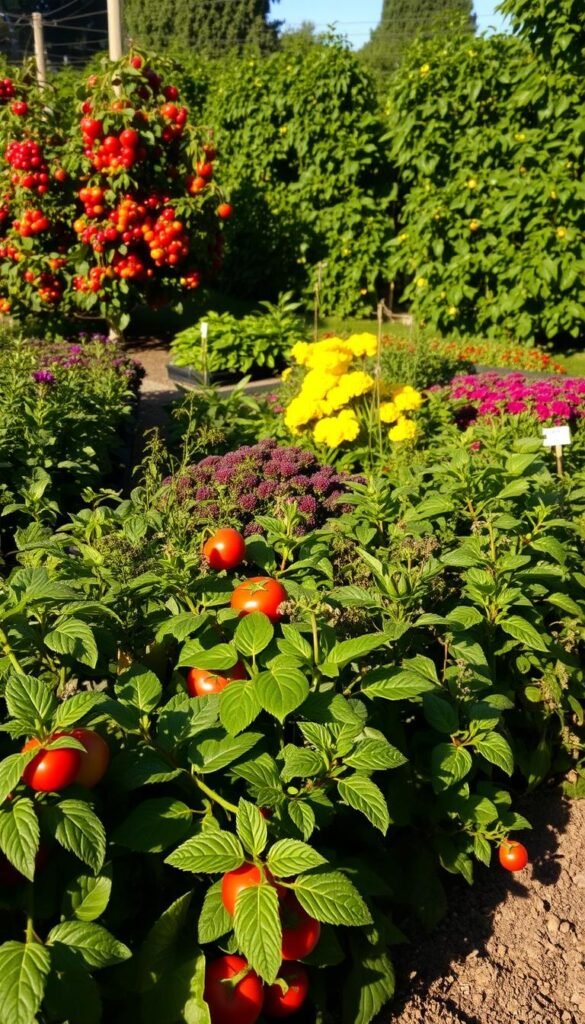
Choosing the right plants is like picking teammates for a winning garden squad. Start by listing your favorite vegetables and herbs, then match them to your space. Love cucumbers? Pair them with vertical trellises. Obsessed with strawberries? Dedicate a sunny corner to these perennial favorites.
Mixing Fruit, Vegetables, and Herbs for Maximum Yield
Smart combinations turn limited space into a bounty. Dwarf apple trees thrive alongside basil bushes—their roots don’t compete. Try these power trios:
- Blueberries + thyme (acid-loving companions)
- Raspberries + garlic (natural pest control)
- Tomatoes + marigolds (blight prevention)
Check your USDA zone before buying fruit varieties. Cold-hardy figs like ‘Chicago Hardy’ survive winters where traditional types fail. For hot climates, ‘Pineapple’ guava handles drought better than most berries.
Balance quick growers with long-term investments. Plant radishes between young asparagus crowns—you’ll harvest roots before the ferns spread. Remember: dwarf plants need 18” spacing, while vining peas require 6” between seeds.
Time your variety choices like a pro. Early strawberries like ‘Honeoye’ fruit weeks before main-season types. Follow with fall-bearing raspberries for three months of snacks. Your taste buds—and pantry—will thank you!
Utilizing Raised Beds, Containers, and Trellises
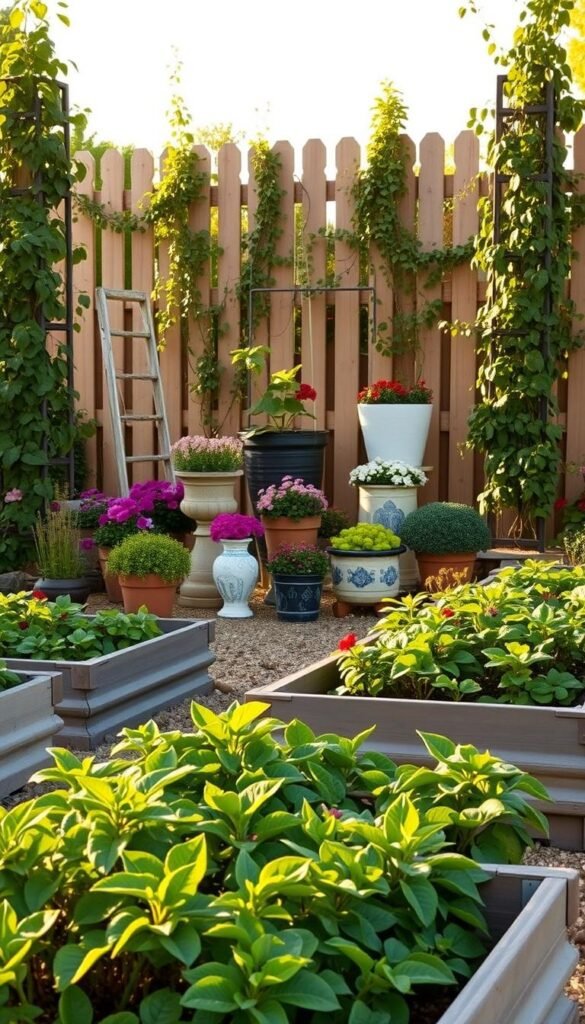
Small-space gardeners are reaping big rewards with these space-savvy solutions. Elevated growing systems let you bypass poor soil conditions while adding visual interest to patios, decks, and urban yards.
Why Elevate Your Garden Game?
Raised beds warm faster in spring, giving plants a 3-week head start. Their loose, nutrient-rich soil prevents root crowding—strawberries produce 30% more berries compared to ground planting. Build frames from cedar or composite boards, keeping width under 4 feet for easy reach.
Containers turn concrete slabs into orchards. Dwarf citrus trees thrive in 15-gallon pots with weekly fertilizer. Group pots on wheeled platforms to chase sunlight across your patio. Just remember: daily watering keeps roots happy during heat waves.
Vertical supports triple your harvests. A simple trellis transforms 1 square foot into:
- 8 pounds of pole beans
- 15 cucumbers
- 20 indeterminate tomatoes
Mix perlite into container soil for better drainage. Line raised beds with hardware cloth to deter burrowing pests. With smart infrastructure, even fire escapes become productive growing zones.
Protecting Your Garden from Pests and Frost Pockets
Your thriving edible oasis needs armor against nature’s nibblers and hidden frost traps. Unprotected plants can lose 70% of their yield to hungry wildlife or unexpected freezes. Let’s fortify your green investment with smart defenses that blend function and beauty.
Animal Barriers That Work
Rabbits chew through tender shoots in minutes. Deer trample fruit trees while reaching for buds. Install 4-foot wire fencing with 1” mesh before planting – bury 6” underground to stop burrowers. For taller protection, try double-layer netting on 8’ posts around berry bushes.
Cold air behaves like water in your garden. Low spots collect frost that kills early blooms. Use this table to identify risky zones:
| Location Feature | Frost Risk Level | Safe Plants |
|---|---|---|
| Bottom of slope | High | Late-blooming apples |
| South-facing wall | Low | Figs, peaches |
| Near solid fence | Moderate | Dwarf pears |
Bird netting shines when sized right. Cover 6-foot trees completely during fruit formation – remove after harvest to let pollinators in. Companion planting adds invisible protection: marigolds repel root pests while attracting ladybugs.
Time your defenses. Apply deer repellent sprays every 3 weeks during growth spurts. Wrap young tree trunks before winter. With layered protection, your garden becomes a fortress that still welcomes butterflies and bees.
Sketching and Mapping Your Garden Layout
Ever tried drawing your garden before planting? Grab graph paper and a ruler—this simple tool helps turn ideas into thriving reality. Start by snapping photos of your space and measuring boundaries. Each square on the grid equals 1 foot, making it easy to plan without guesswork.
Using Graph Paper to Design Your Garden
Map out beds first—keep them 3-4 feet wide so you can reach the center without compacting soil. Leave 2-foot walkways between planting zones for wheelbarrows. Pro tip: Use colored pencils to mark tall plants like pole beans at the north end, mid-height tomatoes in the center, and low-growing herbs up front.
Planning Pathways and Accessible Work Areas
Curved paths add charm but make sure they’re practical. Test your design by laying garden hoses where paths will go—can you maneuver a cart through the turns? Hardscape materials like wood chips prevent mud while letting water seep through.
Smart mappers always:
- Label crops with planting dates
- Note sun patterns from morning to afternoon
- Mark future expansion zones
Your paper blueprint becomes a living document. Update it each season as you discover which plants thrive in specific areas. This visual guide prevents overcrowding and ensures every square foot produces delicious results.
Implementing Step-by-Step Planting and Maintenance
Your edible paradise thrives on smart routines. Position plants along paths you use daily—visibility ensures consistent care. Miniature pear trees near patios get pruned 2x more often than hidden specimens, boosting fruit yields.
Timing Your Planting and Watering Schedule
Sync tasks with nature’s clock. Plant strawberries when soil hits 60°F, and figs after frost danger passes. Containers demand dawn watering in summer—evaporation steals 40% less moisture before 9 AM.
Regular Care and Pruning Techniques
Sharp shears make happy plants. Trim dwarf apples in late winter and mid-summer to maintain 6-foot height. For container blueberries, replace topsoil each spring and fertilize weekly during bloom time.
Track growth phases like a pro:
- Week 1-4: Daily root checks for potted citrus
- Month 2: First compost tea application
- Season end: Mulch berries with pine needles
Healthy soil means fewer headaches. Test pH every 60 days—blueberries crave 4.5-5.5 acidity. Celebrate your first ripe harvest by sharing extras with neighbors. Your dedication now flavors tomorrow’s snacks!

